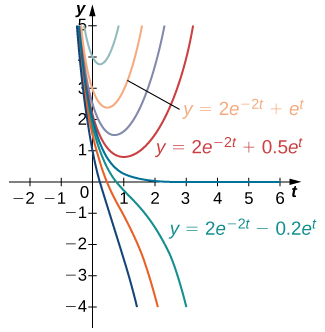| << Chapter < Page | Chapter >> Page > |
A differential equation together with one or more initial values is called an initial-value problem . The general rule is that the number of initial values needed for an initial-value problem is equal to the order of the differential equation. For example, if we have the differential equation then is an initial value, and when taken together, these equations form an initial-value problem. The differential equation is second order, so we need two initial values. With initial-value problems of order greater than one, the same value should be used for the independent variable. An example of initial values for this second-order equation would be and These two initial values together with the differential equation form an initial-value problem. These problems are so named because often the independent variable in the unknown function is which represents time. Thus, a value of represents the beginning of the problem.
Verify that the function is a solution to the initial-value problem
For a function to satisfy an initial-value problem, it must satisfy both the differential equation and the initial condition. To show that satisfies the differential equation, we start by calculating This gives Next we substitute both and into the left-hand side of the differential equation and simplify:
This is equal to the right-hand side of the differential equation, so solves the differential equation. Next we calculate
This result verifies the initial value. Therefore the given function satisfies the initial-value problem.
Verify that is a solution to the initial-value problem
In [link] , the initial-value problem consisted of two parts. The first part was the differential equation and the second part was the initial value These two equations together formed the initial-value problem.
The same is true in general. An initial-value problem will consists of two parts: the differential equation and the initial condition. The differential equation has a family of solutions, and the initial condition determines the value of The family of solutions to the differential equation in [link] is given by This family of solutions is shown in [link] , with the particular solution labeled.

Solve the following initial-value problem:
The first step in solving this initial-value problem is to find a general family of solutions. To do this, we find an antiderivative of both sides of the differential equation
namely,
We are able to integrate both sides because the y term appears by itself. Notice that there are two integration constants: and Solving [link] for gives
Because and are both constants, is also a constant. We can therefore define which leads to the equation
Next we determine the value of To do this, we substitute and into [link] and solve for
Now we substitute the value into [link] . The solution to the initial-value problem is

Notification Switch
Would you like to follow the 'Calculus volume 2' conversation and receive update notifications?